| Ralstonia solanacearum Race 3 Biovar 2 Descalgar la guía descriptiva al formato PDF |
|||
| Roll your mouse over the red-colored words to see word definitions. This will open Pop-up windows. If not, print the glossary |
|||
| Printer friendly |
PDF file |
Glossary |
|
| Symptoms & signs | Causal organism | Disease cycle & epidemiology | Detection & identification | Management | References |
Ralstonia solanacearum race 3 biovar 2 is the plant
A pathogen, or infectious agent, is a biological agent that causes disease or illness to its host. A number of different organisms can cause plant infectious disease. Among them are fungi, bacteria, viruses, nematodes or parasitic plantspathogen A bacterium is a microscopic organism consisting of individual cells. Bacteria cause diseases in many host plants. They can survive on crop residue, seed, or in soil and water; they may be spread by plant or plant cuttings transfer, mechanical means, insects, and seeds bacterium that causes brown rot (or bacterial wilt) of potato, Southern wilt of geranium, and bacterial wilt of tomato.
R. solanacearum race 3 biovar 2 occurs in tropical highlands and in subtropical and some warm-temperate areas throughout the world. It has also occurred in cold-temperate regions in Europe, where several outbreaks of brown rot of potato have been reported in the last 30 years. It has been reported in more than 30 countries and almost all continents.
In the United States, several introductions of R. solanacearum race 3 biovar 2 have occurred as a result of importation of infested geranium cuttings from off-shore production sites, but the pathogen was apparently eradicated. However, because of the risk of its possible re-introduction through importation of infected plant material, and its potential to affect potato production in cold-temperate areas in the northern United States, R. solanacearum race 3 biovar 2 is considered a serious threat to the United States potato industry. It is of quarantine importance and has been listed as a Select Agent plant pathogen under the Agricultural Bioterrorism Act of 2002.
| Symptoms and signs |
In potato and tomato, symptom is a subjective evidence of disease or physical disturbance. It is an evident reaction by a plant to a pathogen, and is not necessarily visible. Different pathogens can induce similar symptomssymptoms induced by R. solanacearum race 3 biovar 2 are very similar. At the early stages of diseases, the first visible symptoms usually appear on foliage of plants. These symptoms consist of wilting of the youngest leaves at the ends of the branches during the hottest part of the day (Photo 1a and 1b).
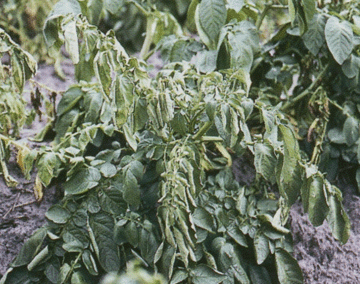 |
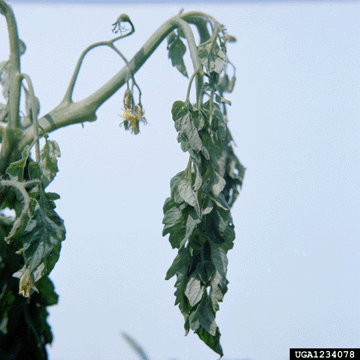 |
|
| Photo 1a. Symptom of brown rot of potato caused by R. solanacearum showing wilting of youngest leaves of plant. (Photo courtesy of D.P. Weingartner – IFAS, University of Florida, Hastings) |
Photo 1b. Symptom of bacterial wilt of tomato caused by R. solanacearum showing wilting of leaves at the end of plant branch. Photo courtesy of Clemson University - USDA Cooperative Extension Slide Series, Bugwood.org) |
|
At this stage, only one or half a leaflet may wilt, and plants may appear to recover at night, when the temperatures are cooler. As the disease develops under favorable conditions, the entire plant may wilt quickly and desiccate, although dried leaves remain green, leading to general wilting and yellowing of foliage and eventually plant death. Another common symptom that can be associated with bacterial wilt in the field is the stunting of plants (Photo 2a and 2b). These symptoms may appear at any stage of plant growth.
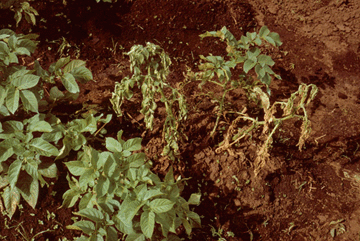 |
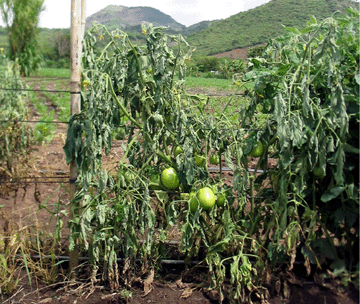 |
|
| Photo 2a. Symptom of brown rot of potato caused by R. solanacearum showing wilting and stunting of plant. (Photo courtesy of David Thurston, Cornell University) |
Photo 2b. Symptom of bacterial wilt of tomato caused by R. solanacearum showing wilting of foliage and stunting of plant. (Photo courtesy of C. Allen, University of Wisconsin) |
In young stems, infected Vascular, or conductive, bundles are responsible for long-distance transport of water and nutrients throughout the plant. Highly developed plants have two types of vascular tissues: the xylem and the phloemvascular bundles may become visible as long, narrow, dark brown streaks. In young, succulent plants of highly susceptible varieties, collapse of the stem may also be observed (Photo 3). |
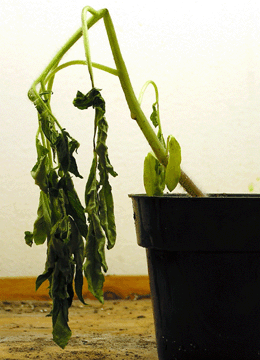 |
Photo 3. Symptom of bacterial wilt of tomato caused by R. solanacearum |
In well-established infections, cross sections of stems or stolon is a slender stem that grows horizontally along the ground, giving rise to roots and aerial (vertical) branches at specialized points called nodes stolons may reveal brown discoloration of infected tissues (Photo 4). |
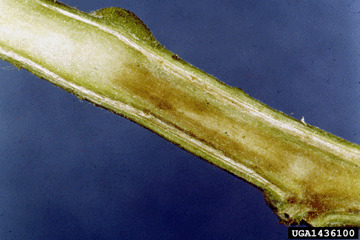 |
Photo 4. Brown discoloration of stem tissues caused by R. solanacearum. |
In potato, brown rot symptoms may be present in tubers at the later stages of disease. Cross-section of infected potato tubers may reveal a grey-brown discoloration of vascular tissues, also called a vascular ring (Photo 5). As infection progresses, the discoloration may extend into the pith or cortex of the tuber. A milky-white sticky exudate (ooze), which indicates the presence of bacteria cells, might also be observed in freshly-cut sections of infected tubers (Photo 5).
Bacterial ooze may also be visible at the eyes or at the point where the stolon attaches to the tuber (Photo 6). These symptoms or symptoms may not be visible early in disease development.
 |
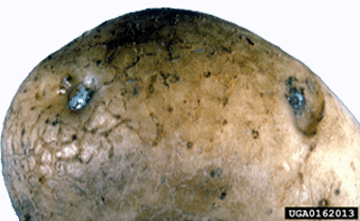 |
|
| Photo 5. Grey-brown discoloration of vascular tissues and bacterial ooze in potato tuber infected by
R. solanacearum. (Photo courtesy of K. Tsuchiya) |
Photo 6. Bacterial ooze exuding from eye of potato tuber infected by
R. solanacearum. (Photo courtesy of Central Science Laboratory, Harpenden Archive, British Crown, Bugwood.org) |
In geranium, symptoms of Southern wilt usually begin with abnormal
Chlorosis is a condition in which leaves produce insufficient chlorophyll. As chlorophyll is responsible for the green color of leaves, chlorotic leaves are pale, yellow, or yellow-whitechlorosis and wilting of the lower leaves. Leaves may also show abnormal upward curling at their margins which is very characteristic of the disease (Photo 7).
At this stage of disease, plants may appear to recover at night, when the temperatures are cooler. Under favorable conditions, the disease develops rapidly and wilting may spread up the plant from older leaves to newer ones. Wilted leaves often become chlorotic then brown
In plant biology, necrosis is the name given to death of plant cells and plant tissue. The tissue first turns brown and subsequently diesnecrotic in wedge-shaped patterns that expand towards the leaf margins. The leaf margins themselves may also become chlorotic then necrotic, and the whole plant may desiccate and die (Photo 8).
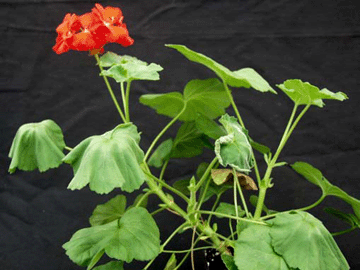 |
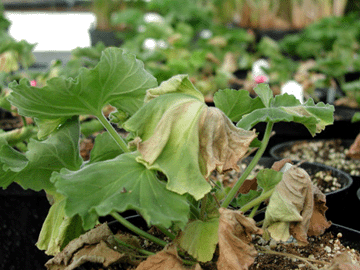 |
|
| Photo 7. Initial symptoms of Southern wilt of geranium caused by R. solanacearum showing wilting and upward curling of leaves. (Photo courtesy of D. Norman, Mid-Florida Research and Education Center, IFAS, University of Florida) |
Photo 8. Symptoms of Southern wilt of geranium caused by R. solanacearum race 3 biovar 2 showing drying and brown necrosis on leaves. (Photo courtesy of the Wisconsin Department of Agriculture, Trade and Consumer Protection) |
At late stages of disease, collapse of the stem may also be observed (Photo 9). Stems and roots may show brown vascular discoloration, blacken and eventually become necrotic (Photo 9, Photo 10).
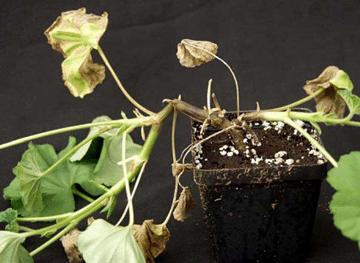 |
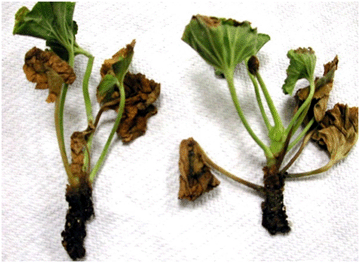 |
|
| Photo 9. Late symptoms of Southern wilt of geranium caused by R. solanacearum race 3 biovar 2 showing blackening and collapse of stem. (Photo courtesy of D. Norman, Mid-Florida Research and Education Center, IFAS, University of Florida) |
Photo 10. Late symptoms of Southern wilt of geranium caused by R. solanacearum showing root blackening. (Photo courtesy of Margery Daughtrey, Cornell University) |
Symptom expression is favored by high temperatures (29-35ºC85-95ºF) and symptoms of the disease may progress rapidly after infection. However, under favorable conditions, symptomless plants may remain latently infected for extended periods of time. After infection the pathogen may survive in and be spread from the infected plant.
A common sign of bacterial wilt of tomato observed at the surface of freshly-cut sections from severely infected stems is a sticky, milky-white exudate, which indicates the presence of dense masses of bacterial cells in infected vascular bundles, and particularly in the The xylem is responsible for transportation of raw sap (water and nutrients) from roots to aerial parts of the plant. R. solanacearum is a limited xylem-invading pathogenxylem (Photo 5). |
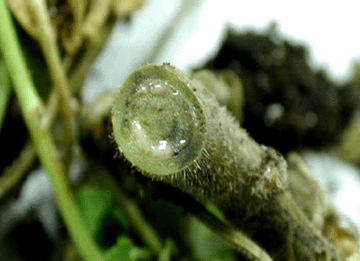 |
Photo 5. Bacterial ooze from freshly-cut section of a geranium stem |
Another common diagnostic sign of the disease can be observed when the cut sections are placed in clear water as shown in Photo 12. It consists of a viscous white spontaneous slime streaming from the cut end of the stem. This streaming represents the bacterial ooze exuding from the cut ends of colonized vascular bundles (Photo 12). |
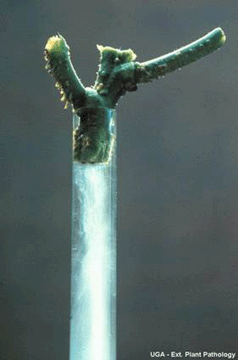 |
Photo 12. Bacterial streaming in clear water from stem cross-section |
R. solanacearum race 3 biovar 2 also infects weeds and native plants, especially members of the The Solanaceae family, also known as the "nightshade" family, is a family of flowering plants, many of which are edible, while others are poisonous. The family includes the Datura or Jimson weed, eggplant, mandrake, deadly nightshade or belladonna, capsicum, potato, tobacco, tomato, and petuniaSolanaceae. In weed hosts, wilt symptoms are rarely observed under natural conditions unless soil temperatures exceed 25ºC77ºF or inoculum levels are extremely high. When wilting does occur, the symptoms are as described for tomato. Solanum dulcamara (woody nightshade or bittersweet) plants growing in water may show internal discoloration of vascular tissues on the stem base without any obvious wilting. Solanum dulcamara has been described as an important weed host of R. solanacearum in England (see the causal organism section).
| Symptoms & signs | Causal organism | Disease cycle & epidemiology | Detection & identification | Management | References |
| Author: | Patrice G. Champoiseau of University of Florida |
| Reviewers: | Caitilyn Allen of University of Wisconsin; Jeffrey B. Jones, Carrie Harmon and Timur M. Momol of University of Florida |
| Publication date: | September 12, 2008 |
| Supported by: | The United States Department of Agriculture - National Research Initiative Program (2007-2010) |

